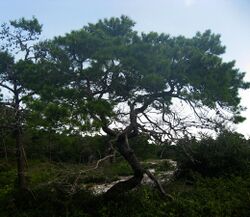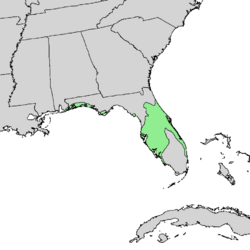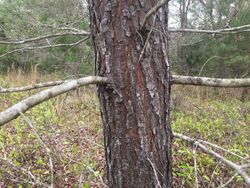Biology:Pinus clausa
| Pinus clausa | |
|---|---|

| |
| Scientific classification | |
| Kingdom: | Plantae |
| Clade: | Tracheophytes |
| Clade: | Gymnospermae |
| Division: | Pinophyta |
| Class: | Pinopsida |
| Order: | Pinales |
| Family: | Pinaceae |
| Genus: | Pinus |
| Subgenus: | P. subg. Pinus |
| Section: | P. sect. Trifoliae |
| Subsection: | P. subsect. Contortae |
| Species: | P. clausa
|
| Binomial name | |
| Pinus clausa (Chapm. ex Engelm.) Sarg.
| |

| |
| Generalized natural range of Pinus clausa | |
Pinus clausa is a species of pine endemic to the Southeastern United States. Its common names include sand pine, Florida spruce pine,[1] Alabama pine, and scrub pine.[2]
Distribution
The tree is found in two separate locations, one across central peninsular Florida, and the other along the western Florida panhandle coast into the Alabama coast. There is a range gap of about 200 km (120 mi) between the populations (from Apalachicola to Cedar Key).[citation needed]
It is largely confined to very infertile, excessively well-drained, sandy habitats where competition from larger-growing species is minimized by the harsh growing conditions of hot sun, fast-draining white sands, and frequent severe seasonal droughts. It is often the only canopy tree in the Florida scrub ecosystem.[citation needed]
Description
Pinus clausa is a small, often shrubby tree from 5–10 m (16–33 ft), exceptionally to 21 m (69 ft) tall.
The leaves are needle-like, in pairs, 5–10 cm (2.0–3.9 in) long, and its cones are 3–8 cm (1.2–3.1 in) long.[3]
Over much of its range, it is fire-adapted to stand-replacing wildfires, with the cones remaining closed for many years (clausa = closed), until a natural forest fire kills the mature trees and opens the cones. These then reseed the burnt ground. Some populations differ in having cones that open at maturity, with seed dispersal not relying on fires.[4]

Uses
Pinus clausa woodlands are an important part of the Florida scrub ecosystem, and provide habitat for the endangered Florida sand skink, among other species. It is one of the few canopy trees able to grow in arid, sandy, and hot locations with minimal care.
While the dense branching makes this tree unsuitable for wood production, it is often used for wood pulp.
References
- ↑ 1.0 1.1 Farjon, A. (2013). "Pinus clausa". IUCN Red List of Threatened Species 2013: e.T34050A2841499. doi:10.2305/IUCN.UK.2013-1.RLTS.T34050A2841499.en. https://www.iucnredlist.org/species/34050/2841499. Retrieved 19 November 2021.
- ↑ {{citation | mode = cs1 | title = Pinus clausa | work = Germplasm Resources Information Network (GRIN) | url = | publisher = [[Organization:Agricultural Research ServAgricultural Research Service (ARS), United States Department of Agriculture (USDA) | access-date = 20 December 2017 }}
- ↑ "Pinus clausa in Flora of North America @ efloras.org". http://www.efloras.org/florataxon.aspx?flora_id=1&taxon_id=233500926.
- ↑ Moore, Gerry; Kershner, Bruce; Craig Tufts; Daniel Mathews; Gil Nelson; Spellenberg, Richard; Thieret, John W.; Terry Purinton et al. (2008). National Wildlife Federation Field Guide to Trees of North America. New York: Sterling. p. 70. ISBN 978-1-4027-3875-3.
External links
- Pinus clausa. USDA PLANTS.
- Pinus clausa. Flora of North America.
Wikidata ☰ Q1259309 entry
 |


